Renaissance Hong Kong Harbour View Hotel Boardroom, Mezzanine Floor
1 Harbour Road, Wanchai, Hong Kong
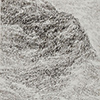
|
Lot: 6001
2008 |
Estimate
10,000 - 30,000 40,000 - 121,000 1,300 - 3,900
|
Sold Price
12,000
48,000
1,548
|

|
Lot: 6002
2010 |
Estimate
40,000 - 80,000 162,000 - 324,000 5,200 - 10,300
|
Sold Price
48,000
192,000
6,194
|

|
Lot: 6003
1985 |
Estimate
75,000 - 100,000 304,000 - 405,000 9,700 - 12,900
|
Sold Price
90,000
360,000
11,613
|

|
Lot: 6004
2014 |
Estimate
75,000 - 100,000 304,000 - 405,000 9,700 - 12,900
|
Sold Price
102,000
408,000
13,161
|
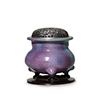
|
Lot: 6005
This censor has a wide mouth with an outwardly folded and flattened rim, and a curved belly that rests on three legs. It is covered inside and out with sky blue glaze with splashes of purple. Since the Jun kilns generally used an opaque finish, the glaze would run when the vessel was burned at high temperatures. Consequently, the glaze is thinner at the edges, where some of the amber body can be glimpsed. At the bottom, however, the glaze is particularly thick and smooth. The pure azure glaze and the splashes of purple merge harmonically for a glowing sunset type of visual effect, very pleasing to the eye. Design and glaze clearly identify this a piece of Yuzhou's Jun kiln, and the exceptional color and beauty of its finish will delight any collector of rare and valuable ceramics. |
Estimate
350,000 - 450,000 1,417,000 - 1,822,000 45,100 - 58,000
|
|

|
Lot: 6006
2012 |
Estimate
28,000 - 38,000 113,000 - 154,000 3,600 - 4,900
|
Sold Price
33,600
134,400
4,335
|

|
Lot: 6007
This ewer has outwardly arched edge, a short neck, and a long, rounded belly. Attached to the neck and belly on one side is an elongated curved rattan design handle. On the opposite side of the handle is a short, round spout. Most Tang dynasty zhihu ewers show this kind of design. The whole vessel is glazed pure white. The finish has a smooth, glossy luster, and is free of impurities. A very fine and representative specimen of a white glazed ewer from the Tang dynasty's Xingyao kiln. |
Estimate
140,000 - 180,000 1,417,000 - 1,822,000 18,100 - 23,200
|
|

|
Lot: 6008
2014 |
Estimate
70,000 - 120,000 283,000 - 486,000 9,000 - 15,500
|
Sold Price
90,000
360,000
11,613
|

|
Lot: 6009
Ding ware is one of the five great ceramic styles of the Song dynasty, and is best known for its white porcelain produced in large quantities for the Northern Song imperial court. This lot, a Ding ware plate with a cotton-rose hibiscus floral design and a scalloped rim, combines a light body with compact texture and a smooth, glossy luster. The glazing is white with a subtle tint of ivory, as is standard for Northern Song Ding ware. The plate's lip is executed in a stylized blossom shape, while its center features an engraving of a hibiscus flower broken at the stem. More commonly seen motifs are day lily or similar conventional floral patterns, giving this item an additional touch of rarity. The elegant design shows smooth and highly practiced craftsmanship, making this a fine example of the superior quality associated with Northern Song Ding ware. |
Estimate
250,000 - 320,000 1,012,000 - 1,296,000 32,200 - 41,300
|
|
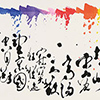
|
Lot: 6010
1988 |
Estimate
130,000 - 200,000 526,000 - 810,000 16,800 - 25,800
|
Sold Price
156,000
624,000
20,129
|
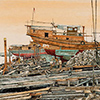
|
Lot: 6011
1988 |
Estimate
40,000 - 80,000 162,000 - 324,000 5,200 - 10,300
|
Sold Price
48,000
192,000
6,194
|

|
Lot: 6012
2014 |
Estimate
38,000 - 60,000 154,000 - 243,000 4,900 - 7,700
|
Sold Price
45,600
182,400
5,884
|

|
Lot: 6013
It is well known that the Yaozhou kiln is most renowned for its celadon ware. This kiln was established during the Tang dynasty, and at first produced mainly plain or white-glazed ceramics with splashes of black. This lot is a Tang Yaozhou teabowl with a wide mouth, rounded belly, and circular foot. The body is unglazed, but the bowl's inside is decorated with a black ink floral design of six blossoms whose stems meet roughly in the floor's center. This is a lot emanating the classic elegance characteristic of Tang dynasty teaware. |
Estimate
80,000 - 120,000 324,000 - 486,000 10,300 - 15,500
|
|

|
Lot: 6014
This brushwash has a five-petaled scalloped rim and a very gently curved belly, with tears on the surface where the glaze has run. The piece is entirely covered with white glaze of a pure, snowy tint and smooth luster, with the exception of the round foot, where the ceramic body is visible. This kind of flower-shaped scalloped rim is frequently seen in Ding ware from the Five Dynasties period, but usually the edge is four-lobed, and five petals as in this lot are much less common. The overall design is imitative of precious metal vessels popular during the Tang dynasty, and this early Dingyao brushwash with its evenly applied, snow-white hue and exquisite workmanship is truly a rare specimen of Five Dynasties Ding ware. |
Estimate
300,000 - 400,000 405,000 - 607,000 12,900 - 19,300
|
Sold Price
384,000
1,536,000
49,548
|

|
Lot: 6015
2014 |
Estimate
15,000 - 30,000 61,000 - 121,000 1,900 - 3,900
|
|

|
Lot: 6016
The production of white ware at the Ding kiln began during the Tang dynasty. Ding ware is known for its firm and yet light and delicately worked ceramic body. The colors are pure, and the vessels highly vitrified. This brushwash has a wide mouth and slanting walls. A decorative day lily design is engraved at the bottom of the floor. The lines are succinct and flowing, and the craftsmanship is meticulous and mature. The pattern is carved into the surface with a great sense of spacing and composition, achieving a highly stylized and aesthetically pleasing visual effect. A good example for the excellent workmanship of Song dynasty potters. |
Estimate
100,000 - 150,000 405,000 - 607,000 12,900 - 19,300
|
|
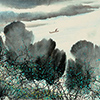
|
Lot: 6017
1988 |
Estimate
30,000 - 50,000 526,000 - 810,000 3,900 - 6,400
|
Sold Price
36,000
144,000
4,645
|

|
Lot: 6018
The black-glazed cover fits snugly on the box and has an attractive decorative tihua pattern. The tihua technique involves covering the ceramic body with engobe, then glazing it black, and finally chipping away parts of the glaze to reveal the desired design. The burning process makes the contrast between the black glaze and the white engobe even more pronounced, creating a lively visual appeal. The center of the cover is adorned with a chrysanthemum design, surrounded by a tendril vine pattern running along the edge. As an everyday utensil, this item allows us to catch a glimpse of life in old China. |
Estimate
120,000 - 160,000 486,000 - 648,000 15,500 - 20,600
|
|
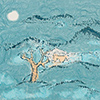
|
Lot: 6019
1988 |
Estimate
40,000 - 60,000 162,000 - 243,000 5,200 - 7,700
|
Sold Price
48,000
192,000
6,194
|

|
Lot: 6020
This censor has a lipped rim, a straight neck, and a rounded belly, and it rests on three feet. The entire vessel has a black glaze finish, inside and out. The finish is thinner at the edges, partly revealing the russet colored body. The glaze was allowed to run during the manufacturing process, and is therefore somewhat thinner around the rim and neck, and slightly thicker at the bottom. This was a very popular design for censors during the Song and Jin dynasties, similar to those found in Jun ware. |
Estimate
120,000 - 160,000 486,000 - 648,000 15,500 - 20,600
|
|

|
Lot: 6021
1988 |
Estimate
18,000 - 30,000 73,000 - 121,000 2,300 - 3,900
|
Sold Price
21,600
86,400
2,787
|

|
Lot: 6022
This bowl has a wide, slightly flaring mouth, curved belly, and round foot. The faintly visible lines wrapping around the outer wall are not decorations, but traces of the casting process. The vessel is completely covered with white glaze, except for the round foot, where the ceramic body is visible, also of a pure white color and smoothly worked. This bowl is comparatively large, and its body is somewhat thinner than the norm. Its snow-white finish and soft luster are still as attractive as they were almost a thousand years ago. |
Estimate
250,000 - 350,000 1,012,000 - 1,417,000 32,200 - 45,100
|
|

|
Lot: 6023
This censor has a thick body, a mouth with a lipped edge, a short neck, and a round belly. It is completely covered in a sky blue glaze, with the exception of the three feet on which the vessel rests. The glaze shows fine crackling from rim to base, and the finish is thinner on top of the mouth, revealing the brown color of the ceramic body. The glaze was allowed to run from the edge of the mouth towards the foot. As a result, the finish is thicker at the bottom, and its luster is particularly smooth and vitreous. Overall, this lot is highly representative of censor style and design during the Song dynasty. |
Estimate
400,000 - 500,000 1,619,000 - 2,024,000 51,600 - 64,500
|
|

|
Lot: 6024
2004 |
Estimate
50,000 - 80,000 202,000 - 324,000 6,400 - 10,300
|
Sold Price
60,000
240,000
7,742
|
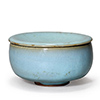
|
Lot: 6025
The entire teabowl is covered with lavender blue glaze of a particularly bright color, and comes with a snugly fitting cover. The round foot has a finish of protective glaze typically seen in top-grade Junyao ware. At the rims of the bowl and cover, the opaque glaze is slightly thinner, revealing the ocher body underneath. Around the outer side of the round foot the glaze is thicker, because the opaque finish was allowed to run and form tears. This is typical for the Northern and Southern Song, an attempt to recreate the texture and appeal of jade. The bowl's design is simple and elegant, and there are no decorative designs of any kind. Its appeal rests entirely on the color and luster of the celadon glaze, and its understated beauty and refinement are expressive of the aesthetic ideals of the Song literati class. |
Estimate
200,000 - 280,000 810,000 - 1,134,000 25,800 - 36,100
|
|

|
Lot: 6026
2009 |
Estimate
32,000 - 48,000 130,000 - 194,000 4,100 - 6,200
|
Sold Price
38,400
153,600
4,955
|

|
Lot: 6027
2014 |
Estimate
20,000 - 40,000 81,000 - 162,000 2,600 - 5,200
|
Sold Price
24,000
96,000
3,097
|

|
Lot: 6028
The cover of this box, which fits snugly onto the bottom part, is very slightly arched. Below the edge of the cover's flat top a protruding decorative line runs all around. Box and lid have a smooth surface without any decorative designs. At the rims and the bottom of the foot the yellow-brown ceramic body is visible, but the rest of the object is covered in celadon glaze of a rich and full color. The simple design and uniform tint give this lot a classic, understated elegance. |
Estimate
150,000 - 200,000 607,000 - 810,000 19,300 - 25,800
|
|
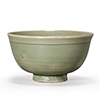
|
Lot: 6029
This teabowl has a wide mouth, a deep, curved belly, and a round foot which arches slightly outwards. It is completely covered with celadon glaze of a light hue, and where the finish is thinner, one can see the traces left by the final touches to the body. The glaze has a highly vitreous texture and was allowed to run, leaving visible marks on the surface. The shape is very similar to the dunshi (broad-bellied) variety, and a decorative band wraps around the bowl directly under the lip. Teabowls from the Yaozhou kilns are most commonly of the douli (bamboo hat) type, and dunshi specimens are rare, making this a worthy addition to any connoisseur's collection. |
Estimate
100,000 - 150,000 405,000 - 607,000 12,900 - 19,300
|
|

|
Lot: 6030
Russet-colored glaze was a specialty of the northern Cizhou kilns during the Song, Jin, and Yuan dynasties. It involves glazing an object black, and then applying an extra layer of coloring agent made from banhuashi, an ore high in iron oxide, to add patterns as an adornment. When the vessel is burned at high temperatures, the iron crystals will give the decorative designs their characteristic russet color and mottled appearance. This teabowl is in a shape frequently seen in Song dynasty Jian ware, and these type of teabowls were so popular that both northern and southern kilns manufactured them. This bowl has an inwardly curved mouth, a deep, wide belly, and a round foot. The entire vessel is covered in black glaze, and adorned with elongated stripes of a rusty color that extend from the rim to the bottom, inside and out. The underside of the foot has a finish of purple-black protective glaze, which is an important distinguishing characteristic of Shanxi kilns (or Huairen ware). During the Song dynasty, tea-tasting contests were a very popular pastime, and the southern kilns, such as Jianyao, could not satisfy the huge demand for exquisite tea utensils. Northern kilns picked up the slack, successfully imitating southern styles and design, such as tuhao and tietai. This bowl has a northern flair, combining rustic charm with fine craftsmanship. |
Estimate
55,000 - 70,000 223,000 - 283,000 7,100 - 9,000
|
Sold Price
66,000
264,000
8,516
|

|
Lot: 6031
This bowl has a curved belly, and its mouth is embellished with a decorative band wrapping around the vessel. Below that, the belly is adorned with vertical, semicircular lines running towards the center of the bowl and reminiscent of a woven wicker design. The entire body is glazed white inside and out, and the wicker stripes were added by chipping away the finish. The ceramic body is a light gray hue, and has a tight texture. The bowl's shape and decorative patterns are imitative of a wickerwork basket, giving this type of vessel its name: liudou bowl. Liudou designs first appeared in Henan ware around the late Tang, and became popular during the Five Dynasties period. Originally, liudou ware was known for the realism of the wicker weave designs, but by the Song dynasty the figurative patterns had become much stylized and simplified. |
Estimate
100,000 - 150,000 405,000 - 607,000 12,900 - 19,300
|
|

|
Lot: 6032
The pillow's surface is shaped like the traditional Chinese ruyi motif, with an arched edge that is cocked up on three sides. The oval body is much narrower than the surface, with the walls slightly slanted and engraved all round with a floral design. The entire pillow is glazed celadon, with a green shimmer to the predominantly white finish. The celadon hue is more pronounced where the glaze is more thickly applied. Where the body is exposed, the pure white of the china clay dominates. The surface has a kaiguang border, but no decorative design of any kind in the center. However, a floral pattern runs along the outer edge of the border, featuring raised and recessed parts to create a bas-relief effect. This large piece of Raozhou ware, preserved without flaw or damage, is highly representative of Northern Song celadon glazed pillows. |
Estimate
650,000 - 850,000 2,632,000 - 3,441,000 83,800 - 109,600
|
Sold Price
780,000
3,120,000
100,645
|
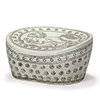
|
Lot: 6033
The surface of this roughly kidney-shaped pillow is very slightly slanted from the lower front to the higher back. Its body has a grayish-white hue and a robust texture. The top and all sides have a white glaze finish with a layer of black glaze underneath. For the decorative pattern, the white glaze was carved out, and the engraved design consists of an outer border with a plum blossom motif, which frames a lion in the center. The animal is captured in a jumping pose, powerful and impressive, and its face, mane, and bushy tail are shown in fine detail. The pillow's sides are visually divided into two parts by several swirl-grained patterns, the top one showing a band of round designs, and the bottom three consisting of a regular arrangement of plum blossoms. The plum blossom patterns on the top and the sides nicely complement each other. Overall, this is a piece of masterly craftsmanship with exquisitely drawn decorative patterns, putting it in the top range of Song dynasty porcelain pillows. |
Estimate
400,000 - 500,000 1,619,000 - 2,024,000 51,600 - 64,500
|
|

|
Lot: 6034
This bowl in the shape of a ten-petaled blossom has a wide belly, and its scalloped rim curves inwards very slightly. The vessel rests on a round foot, and its interior walls are decorated with imprints of tendril vine patterns, while the bottom shows a chrysanthemum design. The whole bowl is covered with Yao ware celadon glaze of a deep, comparatively opaque hue and refined aesthetic appeal. In its entirety, the bowl is designed to resemble a blooming chrysanthemum. Floral imprints are the main type of decorative design used in Yaozhou ceramics, although other motifs, such as animals or human figures, are also used, especially for more stylized designs. Bowls of this particular shape are very rare, making this a very valuable addition to any collection. |
Estimate
120,000 - 160,000 486,000 - 648,000 15,500 - 20,600
|
|

|
Lot: 6035
This jar has a lipped rim and a bulbous belly. It is completely covered with white glaze of a pure tint, and has a very regular shape. The craftsmanship is excellent, the ceramic body firm and well worked. Manufacturing a vessel of this considerable size is rather difficult, and the round lines running around the belly reveal traces from the casting process. It is especially rare to see a Tang jar of these proportions, and with such an attractive glaze, preserved in such good condition, making this a very valuable addition to any collection. |
Estimate
180,000 - 220,000 729,000 - 891,000 23,200 - 28,400
|
|

|
Lot: 6036
The cover of this box, which fits snugly onto the bottom part, is very slightly arched. Box and lid have a smooth surface without any decorative designs. At the rims and the bottom of the foot the yellow-brown ceramic body is visible, but the rest of the object is covered in celadon crackle glaze of a rich and full color. The simple design and uniform tint give this lot a classic, understated elegance. |
Estimate
120,000 - 160,000 486,000 - 648,000 15,500 - 20,600
|
|

|
Lot: 6037
This teabowl has a gently curved belly and a round foot. The white body is comparatively thin, yet smooth and firm. It is covered with glaze inside and out, with the exception of the underside of the foot. The finish is evenly applied, and has a glossy luster free from impurities, giving the bowl an exquisite texture and feel. Purple-red glaze is a relatively rarely seen type of finish in Ding ware, and was praised even in Song dynasty poetry, showing how highly it was valued by people at that time. |
Estimate
600,000 - 700,000 2,429,000 - 2,834,000 77,400 - 90,300
|
|

|
Lot: 6038
Shaped like a blossom, this teabowl has a lobed rim and is covered entirely with white glaze of a smooth, glossy luster. There are no decorative designs of any kind. This type of petaled-edge and ridged-wall ware involves a more complex manufacturing process than other round vessels, and is most commonly seen in late Tang metal objects. In the Song dynasty, people enjoyed modeling objects and utensils on classic designs, and this brushwash is a good example. |
Estimate
35,000 - 45,000 142,000 - 182,000 4,500 - 5,800
|
|

|
Lot: 6039
This teabowl has a conical shape reminiscent of a bamboo hat (douli), with a lip that is curving outwards, and a wide belly tapering towards the relatively small round foot. The bowl is covered inside and out with black glaze, a dark hue looking somewhat like black paint. Among Song dynasty teabowls, the douli is easily the most famous and widely recognized design. Simple yet elegant, douli bowls were very much favored by the Song literati class. This particular item features a classic design and an attractive color suggestive of lacquer-ware. |
Estimate
42,000 - 55,000 170,000 - 223,000 5,400 - 7,100
|
|

|
Lot: 6040
This teabowl has a gently arched belly and a round foot. It is completely covered with bluish-white glaze, and both its inside and outside are decorated with an ocean wave design, with more finely chiseled water ripples incised within the deeper grooves of the swell. The carving is meticulous and detailed, and there are two sea dragons engraved on the inside, mythical creatures with a dragon's body and a fish's tail. This auspicious design symbolizes the prosperity and refined lifestyles of the Song dynasty. |
Estimate
140,000 - 180,000 567,000 - 729,000 18,100 - 23,200
|
|
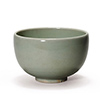
|
Lot: 6041
During the Jin dynasty, Yaozhou kilns began to increasingly produce ceramics with a bluish-white glaze (called yuebai or moon-white). This teabowl is a typical specimen. It has an yuebai finish inside and out, with a particularly vitreous texture and luster. The vessel is broad-bellied, and its lip is very slightly curved inwards. The deep, rounded belly rests on a round foot. Overall, a decorous design with a classical elegance; the workmanship is excellent. |
Estimate
50,000 - 65,000 202,000 - 263,000 6,400 - 8,400
|
Sold Price
90,000
360,000
11,613
|

|
Lot: 6042
The imperial Ding kiln was one of the five most important kilns during the Song dynasty, and it is best know for its white porcelain. This rare Dingyao dish with a peony design and widely flaring sides is entirely covered with pure, snow-white glaze, which is among the best found among all Ding ware. The walls are decorated with stylized floral designs, and the center of the dish is embellished with an engraving of a peony broken at the stem. The flower dominates the overall design, and the carving shows smooth and highly practiced craftsmanship. The texture is firm, and the glaze has a glossy luster. A piece that should easily find a buyer. |
Estimate
300,000 - 400,000 1,215,000 - 1,619,000 38,700 - 51,600
|
|

|
Lot: 6043
This teabowl is shaped like a douli bamboo hat, its rim is curving slightly outwards, and it rests on a small round foot. The inside of the bowl is finished with black glaze grained with rust-colored streaks, brought out by burning the high-iron glaze at high temperatures. The visual effect is pleasant to the eye and invites fancy reveries. On the outside, the textured black glaze extends one third downwards from the edge. This kind of decorative streaked black glaze is typical for Song dynasty Cizhou ware, and during the Song/Jin period this technique had reached a high level of maturity and popularity. |
Estimate
45,000 - 65,000 182,000 - 263,000 5,800 - 8,400
|
Sold Price
55,200
220,800
7,123
|

|
Lot: 6044
2015 |
Estimate
10,000 - 20,000 40,000 - 81,000 1,300 - 2,600
|
|
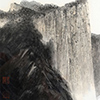
|
Lot: 6045
2014 |
Estimate
10,000 - 20,000 40,000 - 81,000 1,300 - 2,600
|
Sold Price
9,000
36,000
1,161
|

|
Lot: 6046
The jar has a round-rimmed, oblate mouth, a thick neck, and a round foot. Two lugs are attached to the sides at shoulder height. The vessel's belly is decorated with dozens of crisscrossing diagonal lines, creating the impression of a woven bamboo basket. For this reason, this type of ware is also called fish basket jar. A finish of black glaze is applied to the whole body, with the exception of the mouth's rim, where the white ceramic body is visible, and the round foot, which is covered with a light brown protective glaze. This type of vessel required a complex manufacturing process. Combining classical, unpretentious beauty with an attractive, lively design, this jar is a piece of top-notch Yao ware from the Song/Jin era. |
Estimate
140,000 - 180,000 567,000 - 729,000 18,100 - 23,200
|
Sold Price
168,000
672,000
21,677
|
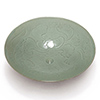
|
Lot: 6047
This dish has wide, rounded sides tapering towards the small, round foot. The entire vessel is covered with a light celadon glaze, a hue reminiscent of the surface of a lake. A floral design showing peonies is carved into the inside, and the veining of the petals incised with a smaller grating knife. The finish is thicker in the pattern's grooves, highlighting the darker lines in a naturally elegant fashion. The glaze has a smooth, clean luster, and the decorative design is of exquisite workmanship: the simple and concise lines effortlessly convey the distinguished beauty and noble refinement associated with the peony. The outer side under the dish's rim is adorned with two rows of simply executed curly cloud patterns wrapping around the whole vessel. Its fine craftsmanship and delicate artistic design put one in mind of Tang dynasty precious metal artifacts, since the Song literati class much admired the aesthetic ideals of earlier periods. This Yue ware dish will make a worthy addition to any aficionado's collection. |
Estimate
220,000 - 280,000 891,000 - 1,134,000 28,400 - 36,100
|
|

|
Lot: 6048
Song Dynasty porcelain figurines had a number of symbolic meanings, such as praying for a woman to give birth to a boy, or denoting a desire for peace, prosperity, and harmony. They were also meant to ward off evil. This lot was mainly a bibelot, meant to be displayed on a desk or shelf to supply a sense of aesthetic refinement. It has a highly artistic flair and is quite large—in fact, it is the largest of its kind. The figurine was originally colorfully painted, but over long centuries the paint has flaked off, leaving only the exquisitely worked, pure white ceramic body. Overall, the sculpture is meticulously crafted, capturing the innocent air of a child. The bun is bound with a ribbon, the eyes are expressive; the well-rounded nose, small mouth, and big earlobes are all considered to be auspicious features. On the chest lies an elaborate necklace of jade and pearls, the arms are adorned with bracelets, and the body rests on a globe: the child is in a resting pose. Under the long-sleeved shirt he wears an apron and pants with an open crotch, allowing a glimpse of the privates. He is also wearing cloth shoes. As for its craftsmanship, this sculpture differs from the porcelain figurines of northern kilns, which are m o s t l y a s s e m b l e d f r o m molds and tend to favor prone postures. By contrast, Jingdezhen ware is usually kneaded into shape by hand, after which the finer details are added by carving or engraving. This new method of three-dimensional sculpting enabled artists to achieve an even more natural and lifelike appearance in terms of posture, dress, and facial expression. |
Estimate
2,500,000 - 3,200,000 10,121,000 - 12,955,000 322,400 - 412,600
|
Sold Price
3,120,000
12,480,000
402,581
|

|
Lot: 6049
The upper surface of this waist-shaped pillow curves slightly upwards from front to back. The entire object is covered with tihua carving. The top shows a lotus flower with leaves. The veining of the leaves is meticulously worked, and the central design is surrounded by a wavy pattern running along the top's edge. The body is unglazed. The tihua method involves covering the ceramic body with engobe, then outlining the desired patterns on the surface, incising the fine veining, and finally chipping away the areas that are not part of the design. This results in the white body and the light brown engobe patterns forming a wonderful contrast. At the time, this was a revolutionary technique, which pioneered a whole new type of Ding ware porcelain pillows. |
Estimate
550,000 - 700,000 2,227,000 - 2,834,000 70,900 - 90,300
|
Sold Price
660,000
2,640,000
85,161
|
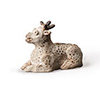
|
Lot: 6050
Jizhou, located in what is today Ji'an's Yonghe Township, was a famous private kiln of the Song dynasty. (During the Sui, Tang, and Song dynasties, Ji'an was called Jizhou.) Most of the ceramics made there were everyday utensils with glazes in a large variety of colors. On the other hand, Porcelain sculptures from Jizhou, such as this lot, are comparatively rare. This item is an auspicious deer in a lying position, its entire body covered with brown spots. The head looks very animated, and the facial features, horns, and ears are meticulously carved. The sculpture exudes a naive charm. As a rare porcelain figurine from Jizhou, this lot makes a worthy addition to any collection. |
Estimate
55,000 - 70,000 223,000 - 283,000 7,100 - 9,000
|
Sold Price
66,000
264,000
8,516
|

|
Lot: 6051
The Gong County kiln is one of the renowned kilns of the Tang dynasty, producing a wide variety of items, many of which were everyday utensils. It is also known for its sancai ware. Most Gong ware has a white, black, or sancai finish. This jar has a curved belly, and two lugs are attached to its sides. About two thirds of the vessel are covered with black glaze, which was allowed to run from the edge towards the foot without reaching it. Instead, it dried into distinct tears on the body's surface. The finely worked ceramic body, visible in the lower parts of the jar, is of a near-white hue. |
Estimate
65,000 - 80,000 263,000 - 324,000 8,400 - 10,300
|
|

|
Lot: 6052
The teabowl has an outwardly curved rim and an arched belly tapering towards the round foot. The decorative designs are a combination of carvings and impressions. The interior has delicately carved veining, while the outer walls feature a curved-stalk lotus design. Of all the different types of embellishment found in Yaozhou ware, carvings are the most vivid and lifelike, and the technique reached its maturity during the Northern song. The engravings on this bowl show deft and well-practiced craftsmanship. The lines are smooth, lucid, and elegantly flowing. The curved lines in particular bring out the beauty of the glazing, making the decorative designs even more aesthetically pleasing. |
Estimate
50,000 - 65,000 202,000 - 263,000 6,400 - 8,400
|
|

|
Lot: 6053
Ceramic cosmetics boxes can be divided into several categories, including ones for cream, powder, and rouge. The lid generally fits snugly onto the box. Of these two lots, one is celadon glazed and the other red glazed. The cover of the celadon specimen is adorned with a five-petaled flower of concise design; around the edges of the petals, the color of the glaze is darker. The other box is entirely covered with red glaze without any decorative designs. The glaze is evenly applied, and the colors are very pure. |
Estimate
45,000 - 60,000 182,000 - 243,000 5,800 - 7,700
|
Sold Price
55,200
220,800
7,123
|
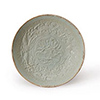
|
Lot: 6054
This dish has a wide mouth, a gently curved belly, and an unglazed rim. The inner wall of the plate is decorated with various designs. A meandering pattern runs along the inner side of the rim. Inside is a floral design of peonies with densely arranged stems and leaves, amongst which there are two phoenixes soaring elegantly in a counterclockwise direction. At the center of the floor is a lotus design. The compact composition with various floral patterns and the harmonic phoenixes creates a pleasant overall visual effect. The veining of the leaves is finely carved; the two birds are natural and lively. A true treasure of Song dynasty Hutian ware. |
Estimate
65,000 - 85,000 263,000 - 344,000 8,400 - 11,000
|
|

|
Lot: 6055
AN EXTREMELY RARE AND VERY LARGE DINGYAO BOWL CARVED WITH FLOWERS
Northern Song Dynasty (AD960-1127) This open-mouthed bowl has deep, rounded sides and a round foot, and is covered inside and out with white glaze. The outside is smooth without any decorative design, while the inside is engraved with a floral pattern showing day lilies, broken at the stem, with crisp, plump blossoms and unfolded leaves. The bowl is somewhat unusual in that it has a decorative design on its interior, extending from the center all the way up the sides. Traditionally, Ding ware is most commonly embellished at the object's bottom or outer sides. In China, day lilies have been auspicious symbols since ancient times, and they are frequently seen in Song dynasty pottery. |
Estimate
1,600,000 - 2,000,000 6,478,000 - 8,097,000 206,300 - 257,900
|
Sold Price
1,920,000
7,680,000
247,742
|

|
Lot: 6056
The jar has a lipped edge, round belly with a melon ridge design, and a fairly broad round foot curving slightly outward. The body is white, compact, and robust, and has a finish of white glaze that is firmly attached to the ware, except at the round foot and the lowest part of the belly just above the foot, where the body is visible. The walls of the jar are somewhat thicker than usual. The jar's distinctive design and excellent craftsmanship make it a top-grade specimen of Northern Song Cizhou ware. |
Estimate
40,000 - 50,000 162,000 - 202,000 5,200 - 6,400
|
|

|
Lot: 6057
2014 |
Estimate
38,000 - 60,000 154,000 - 243,000 4,900 - 7,700
|
Sold Price
78,000
312,000
10,065
|
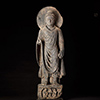
|
Lot: 6058
The Buddha wears a loose coat covering both shoulders and falling in folds over the body. He stands barefooted on a square plinth, and his facial features are both delicately handsome and solemn. His wavy hair is combed back and gathered into a bun (ushnisha) on the top of his head. In the middle of his forehead, between the eyebrows, is the baihao (white hair), a little round spot or curl which is a symbol of the Buddha. His almond-shaped eyes are looking downward, and his mouth is firmly closed. Behind and above him is a disc-shaped halo without any decorative patterns. |
Estimate
600,000 - 800,000 2,429,000 - 3,239,000 77,400 - 103,200
|
Sold Price
780,000
3,120,000
100,645
|

|
Lot: 6059
2014 |
Estimate
28,000 - 48,000 113,000 - 194,000 3,600 - 6,200
|
Sold Price
33,600
134,400
4,335
|

|
Lot: 6060
A very rare piece. Crisply modeled and carved with wide set almond shaped eyes, a straight nose and full lips, all below wavy hair gathered into a domed ushnisha and between elongated earlobes, traces of pigment. |
Estimate
100,000 - 150,000 405,000 - 607,000 12,900 - 19,300
|
Sold Price
120,000
480,000
15,484
|
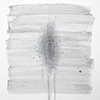
|
Lot: 6061
2014 |
Estimate
40,000 - 80,000 162,000 - 324,000 5,200 - 10,300
|
Sold Price
48,000
192,000
6,194
|

|
Lot: 6062
Much of the arms of this back screen style stone Bodhisattva is lost, so we do not know what he was holding in his hands. The lower part of his skirt (below the knee) is also gone. Overall, it is likely that this was originally an item showing three or more Bodhisattvas in front of a back screen. Judging from the damaged fragments at both sides, as well as the fact that the Bodhisattva's appears to be slightly inclined to the left, we can conclude that originally he was standing to the right of the main statue. Looking at the artistic approach, we find that the Bodhisattva is wearing a coronet adorned with some kind of vine pattern, with the hair bun kept flat and close to the head. The Bodhisattva's face is long, but round and full, and his features are carved with simple lines that yet manage to convey both dignity and kindness. He is wearing light and short garments, in addition to which a cape is draped over his shoulders, segueing into a floating celestial dress that falls over the arms at the elbows. He wears a long skirt gathered at the waist with a rope, and the upper part of the skirt is embellished with decorative knots and patterns. The folds of the skirt are falling vertically towards the lower seam of the garment, adding to the visual impression of height and erect posture. Even though this is only a side statue, it is very finely modeled with mature technique, leaving one to suspect that the original main statue was probably executed with even more exquisite craftsmanship. |
Estimate
550,000 - 700,000 2,227,000 - 2,834,000 70,900 - 90,300
|
|

|
Lot: 6063
2014 |
Estimate
28,000 - 48,000 113,000 - 194,000 3,600 - 6,200
|
Sold Price
33,600
134,400
4,335
|

|
Lot: 6064
2015 |
Estimate
260,000 - 350,000 1,053,000 - 1,417,000 33,500 - 45,100
|
Sold Price
312,000
1,248,000
40,258
|

|
Lot: 6065
A jingping, or waterpot, is one of the 18 things a Buddhist monk should carry. It was used to carry a water supply during travels, both for drinking and for washing hands. These vessels originated in India, the home of Buddhism, but were later brought to China, Japan, Korea, and other places as the religion traveled east. The Chinese term jingping is a phonetic rendering of the original Sanskrit words. The waterpots that were popular during the Tang and Song dynasties had long, tubular necks, elongated round bellies, round feet, and short, upright spouts attached to the vessel's shoulder. This item is entirely covered in dark tea dust glaze, and has a long neck, elongated bulbous belly, and a round, outwardly curved foot. The spout is attached to the upper half of the belly, with its upper part shaped like an alms bowl or teacup. Unlike commonly found everyday utensils, the jingping falls in the category of specialized Buddhist items, making this black glazed waterpot from the Song dynasty a particularly rare and attractive lot. |
Estimate
300,000 - 400,000 1,215,000 - 1,619,000 38,700 - 51,600
|
|
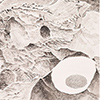
|
Lot: 6066
2013 |
Estimate
100,000 - 180,000 405,000 - 729,000 12,900 - 23,200
|
Sold Price
120,000
480,000
15,484
|

|
Lot: 6067
2011 |
Estimate
140,000 - 200,000 567,000 - 810,000 18,100 - 25,800
|
Sold Price
168,000
672,000
21,677
|

|
Lot: 6068
2000 |
Estimate
160,000 - 240,000 648,000 - 972,000 20,600 - 30,900
|
|

|
Lot: 6069
This jar has a small mouth, short neck, bulbous belly, and octangular shape. A pair of lugs is attached to both the shoulder and the round foot. The protruding ridgelines divide the belly's surface into distinct sections, which are embellished with simple floral patterns that are pleasing to the eye. There also are rope-like designs made up of curved lines reaching from the top to the bottom of the vessel. No finish was applied to the round foot, where the ocher tint of the clay is showing. This jar was used as a water container, and ropes could be passed through the lugs for carrying it around. More than a millennium old, this utensil is preserved in a very good condition, still bearing witness to the ancients' ideal of sophisticated living. |
Estimate
250,000 - 350,000 1,012,000 - 1,417,000 32,200 - 45,100
|
|

|
Lot: 6070
2015 |
Estimate
30,000 - 50,000 526,000 - 810,000 3,900 - 6,400
|
Sold Price
36,000
144,000
4,645
|

|
Lot: 6071
At first glance, these two Yaozhou Carved Meiping vases look very similar, but in fact their decorative patterns are not the same. Both vases have a small mouth with a rolled lip, broad shoulders, and a belly that tapers towards the bottom. Both are long and narrow, standing tall and erect, and are embellished with unique designs. The decorative patterns consist of straight, smoothly flowing lines that are skillfully drawn, giving them a rather modern feel. One vase has a sort of web design made up of crossing lines, while the other features abstract mountain patterns. Both vases are covered in green glaze, with the finish thicker in the line grooves, further accentuating the design. The walls of the vases are robust and slightly thicker than usual. This pair of vases displays all the typical characteristics found in Yaozhou celadon ware, while at the same time boasting distinctive decorative designs, making this a very special set. |
Estimate
2,000,000 - 2,500,000 8,097,000 - 10,121,000 257,900 - 322,400
|
|
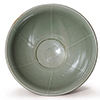
|
Lot: 6072
This bowl with a flaring rim is the biggest currently known specimen of this particular design from the Yao kiln. It is completely covered with celadon glaze of a lucid hue, and its inside is embellished with six symmetrically placed thin decorative stripes, running vertically from the lip to the circle at the center. The belly arches towards the small round foot, which is very neatly worked. Overall, the design is simple yet classically elegant, as befits a major specimen from northern China's Yao kiln. |
Estimate
250,000 - 350,000 1,012,000 - 1,417,000 32,200 - 45,100
|
|

|
Lot: 6073
The object is entirely covered with sky blue celadon glaze of a pure and elegant hue. It comes with a lid that fits snugly onto the bowl, and a protruding round band wrapping around bowl and cover where they meet. This teaware has a simple yet appealing symmetrical design and is adorned with four lugs. A plain decorative band runs around the bowl right under the lugs, while the cover is surmounted with a pumpkin-shaped knob. In terms of both design and color, this set exudes a classic simplicity that is bound to attract connoisseurs of simple elegance. |
Estimate
150,000 - 200,000 607,000 - 810,000 19,300 - 25,800
|
|

|
Lot: 6074
This floral teabowl has a smooth surface that is completely covered in black glaze, except at the bottom of the round foot, where the ceramic body is visible. The subtly scalloped rim opens out wide. The bowl's interior walls are embellished with for decorative lines, and the bottom features an imprint of two fishes facing each other within an ocean wave design that covers the entire floor. The imprint is very clear, with the fish scales and the lines of the waves lucid and distinctive. The fishes' eyes in particular are little strokes of genius, looking vivid and true to life. Most Ding ware, especially from the Five Dynasties period, has a white glaze finish, making this black specimen a true rarity. |
Estimate
250,000 - 350,000 1,012,000 - 1,417,000 32,200 - 45,100
|
Sold Price
384,000
1,536,000
49,548
|

|
Lot: 6075
The mouth is slightly bent outwards, the neck short, and the shoulder has a very slight sideways slant. Four decorative extensions are attached to the shoulder, half resting on the conspicuous transition to the belly. The latter is long, slightly rounded, and tapers towards the broad round foot. The belly is engraved with lotus blossoms and leaves, with mandarin ducks swimming in between. The lotus blossoms show delicate veining, as do the leaves. The feathers and bodies of the ducks are carved in a similarly meticulous fashion, and are embellished with fine parallel lines and semicircular designs. The birds are captured in motion, wriggling and apparently in pursuit of each other. The lower part of the jar's belly is adorned with two rows of a lotus petal pattern, giving the design a clear structure. The taut overall composition and scrupulously executed details imbue the decorative design with depth and vivid complexity, which is particularly rare in a vessel of such small proportions. Altogether, a piece of top-grade Yue ware. |
Estimate
380,000 - 500,000 1,538,000 - 2,024,000 49,000 - 64,500
|
|

|
Lot: 6076
Historically, the Longquan kiln was one of the most important manufacturers of celadon ware, with items stemming from the Southern Song enjoying the highest reputation for outstanding quality and design. A wide range of different objects was made by Longquan potters, with many distinct types of glaze being used, such as pastel green (fenqing), plum green (meiziqing), and winter green (dongqing). This bowl has a broad mouth, arched belly, and rests on a small round foot. The entire vessel is covered with a fenqing celadon glaze, and the finish is thick and smooth, and has a sheen and luster reminiscent of jade. In the protruding parts, the color is particularly light and delicate, while it is somewhat deeper and fuller in the grooves. All this adds to the impression of refinement, as does the lotus petal pattern engraved on the bowl's outer wall. The foot is very cleanly and neatly worked, and the ceramic body showing underneath is of a gray-brown hue. All in all, a very characteristic specimen of Southern Song Longquan ware, with an appeal that is highly suggestive of green jade. |
Estimate
350,000 - 400,000 1,417,000 - 1,619,000 45,100 - 51,600
|
|

|
Lot: 6077
The larger size of this vessel distinguishes it from standard liudou (wicker basket) style cups, and this bowl was probably used to keep liquor or food warm. It has an outwardly extended edge, slightly narrowed neck, ample belly, and round foot. Its shoulder is embellished with two parallel bowstring patterns, while the round belly boasts a carved concentric design of rounded arcs that loosely resembles a wicker weave. The entire body, inside and outside, has a finish of dark celadon glaze with a relatively glassy luster and many minute bubbles. The body has a light gray hue and a fine texture. The shape and decorative patterns of this bowl are reminiscent of a wicker basket, thus the Chinese designation liudou bowl. Liudou motifs first appear in Yaozhou ware during the late Tang dynasty, and became very popular during the Five Dynasties era. Originally, liudou ceramics were known for the realism of the wicker weave designs, but by the Song dynasty the figurative patterns had become much simplified. |
Estimate
200,000 - 280,000 810,000 - 1,134,000 25,800 - 36,100
|
|

|
Lot: 6078
A jar with a lipped rim, straight neck, and slightly slanting shoulders that are adorned with four evenly spaced ring-shaped handles that are purely decorative. From the shoulder downwards, the belly at first curves slightly outwards, but then slants back inwards at an increasing angle. The body is embellished with an elaborate flower pattern. The veining of the petals is delicately carved, and the floral design wrapping around the entire jar is highly representative of Yue ware. The jar is covered in a celadon glaze, except at the rim and the round foot, where the brown-gray body shows. As is not often the case, the lid was preserved together with the jar, giving this item additional rarity value. |
Estimate
400,000 - 500,000 1,619,000 - 2,024,000 51,600 - 64,500
|
|
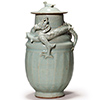
|
Lot: 6079
The jar's mouth is staggered in three decreasing levels, and a sculpted dragon figurine is attached to the shoulder, with its body and claws hugging the vessel tightly as it crouches near the rim. The dragon, in particular its head and body, is executed in fine and vivid detail, as is the upturned lotus petal design engraved on the jar's belly. The entire jar is glazed celadon, and in places where the finish is more thickly applied, it segues into a sky blue hue. Crackle glaze is evident in both jar and cover. The cover is surmounted with a little swallow figurine, and fits snugly onto the jar. This kind of Longquan dragon jar with a cover requires a complex manufacturing process, and the number of finished products is quite small, making this a truly rare item. |
Estimate
750,000 - 950,000 3,036,000 - 3,846,000 96,700 - 122,500
|
|
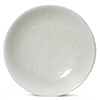
|
Lot: 6080
The production of white ware at the Ding kiln began during the Tang dynasty. Ding ware is known for its firm and yet light and delicately worked ceramic body. The colors are pure, and the vessels highly vitrified. This brushwash has a wide mouth and slanting walls. A decorative day lily design is engraved at the bottom of the floor. The lines are succinct and flowing, and the craftsmanship is meticulous and mature. The pattern is carved into the surface with a great sense of spacing and composition, achieving a highly stylized and aesthetically pleasing visual effect. A good example for the excellent workmanship of Song dynasty potters. |
Estimate
220,000 - 300,000 891,000 - 1,215,000 28,400 - 38,700
|
|

|
Lot: 6081
This teabowl has a flaring lip, curved walls, and a round foot. It is completely covered with sky blue glaze, except for the round foot. Jun ware comes in an incredible variety of beautiful colors, and this bowl with its very evenly applied azure finish is a prime example. The glaze is thinner at the rim, where some of the ceramic body's ocher hue is revealed. Close to the round foot, the finish is somewhat thicker than elsewhere, because the opaque glaze was allowed to run. A simple yet attractive design that is certain to find its admirers. |
Estimate
80,000 - 120,000 324,000 - 486,000 10,300 - 15,500
|
|

|
Lot: 6082
During the Song and Jin dynasties, craftsmen at the Cizhou kilns began to employ a new technique called tihua, which involved glazing an object black and then creating decorative patterns by chipping away parts of the glazing to reveal the white clay underneath. The strong contrast of black and white makes for a vivid visual effect. Most tihua ware was made in northern China, especially in the Cizhou kilns and in the Western Xia (Tangut) Empire. This Meiping vase has an outwardly curved lipped edge, a short neck, sloping shoulder, and gently curved belly. The entire vase is glazed black, with the exception of the round foot, where the finish was scraped away to avoid that the vessel would became attached to the kiln equipment. Several horizontal lines divide the decorative design into two parts, with the upper showing a curly cloud design going all around the vase, and the lower a lively floral design that has a strong visual impact and also wraps around the whole vase. The black glaze has a smooth, glossy sheen, while the raised and recessed parts of the tihua approach create a pleasant bas-relief effect. Overall, this vase is a good example for the bold craftsmanship and rough beauty of Cizhou ware. |
Estimate
100,000 - 150,000 405,000 - 607,000 12,900 - 19,300
|
|

|
Lot: 6083
This bowl has an outwardly curved rim and wide rounded sides rising from a round foot. It is glazed white inside and out. The finish on the outside is smooth without any decorative design, but the inside is carved with a pattern of day lilies. The body is thin and light, and the elegant floral design consists of simple but expertly drawn expressive lines. The bottom and foot in particular bespeak superior workmanship, while the floral pattern is compactly composed to extend from the center to the rim in a naturally flowing flourish. A very good example of the classical and refined beauty that is a trademark of Ding ware. In spite of its great age, the item is in an excellent condition. |
Estimate
500,000 - 650,000 2,024,000 - 2,632,000 64,500 - 83,800
|
|
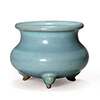
|
Lot: 6084
The censor has a mouth with an outwardly curved edge, a short neck, and a bulging belly. It rests on three feet, with neck, belly, and feet well proportioned. The censor's overall dimensions give a well-rounded and smooth impression, and it lies pleasantly in the hand. A thick layer of lavender blue glaze is applied to the entire vessel, giving the body fullness and finish. This lot is an exquisite and highly representative specimen of Song Junyao pottery. |
Estimate
300,000 - 400,000 1,215,000 - 1,619,000 38,700 - 51,600
|
Sold Price
360,000
1,440,000
46,452
|

|
Lot: 6085
The entire body is glazed in bluish-green monochrome, and the bowl's rim arched outwards. The inside of the bowl is engraved with a decorative tree leaf design, outlining in a few masterful, expressive strokes the shape and venation of the leaves. The color of the glazing is deep and on the dark side, yet refined and elegant. The bowl rests on a round foot, and the center of its interior is embellished with a neatly carved little turtle. |
Estimate
100,000 - 150,000 405,000 - 607,000 12,900 - 19,300
|
|

|
Lot: 6086
During the Western Jin dynasty, pottery and ceramics manufacturing techniques matured considerably. Pieces from this period boast a smooth, refined body and a lustrous glaze, and they come in all kinds of shapes and designs. Utensils such as censors and water-pots were produced in large numbers, and were often embellished with a wide range of patterns and designs. This was facilitated by the improvement of carving, sculpting, and molding techniques, allowing the manufacture of items both useful and aesthetically pleasing. This lot is a sculpture of a lion, usually meant to ward off evil and bad luck. It has an impressive mane, a pair of eyes looking straight ahead, and two ears cocked in attention. The teeth are exposed in a threatening fashion. The animal is crouching on the ground with bent legs, and its body is surmounted with a round knob that is flattened at the top. Such sculptures were quite common during the Western Jin, but more research is needed to determine precisely why they were so popular, or what they signified and how they were used. |
Estimate
300,000 - 400,000 1,215,000 - 1,619,000 38,700 - 51,600
|
|

|
Lot: 6087
Rust-colored glaze is a special technique associated with northern China's Yaozhou kiln during the Song and Jin dynasties. It involves glazing an object black, and then applying an extra layer of coloring agent made from banhuashi, an ore high in iron oxide, to add patterns as an adornment. When the vessel is burned at high temperatures, the iron crystals will give the decorative designs their characteristic russet color and mottled appearance. This jar has a deep, curved belly, a lipped edge, and a round foot. Two miniature handles are attached to the shoulder. The body has a finish of black glaze, and is embellished with broad, rusty-colored vertical stripes all round the bowl. The item boasts an unpretentious beauty, and is a genuinely unique specimen of russet-splashed black-glazed Yaozhou ware. |
Estimate
250,000 - 350,000 1,012,000 - 1,417,000 32,200 - 45,100
|
|

|
Lot: 6088
Sancai ceramics were produced in large amounts during the Tang dynasty, but in the Song era their popularity decreased rapidly. This lot stems from the Five Dynasties, which marked a transition period between the Tang and the Song eras. The glaze is relatively thinly applied, without any obvious traces of running, such as tears. The plate shows the three most commonly used colors in Sancai pottery: green, amber, and white. The awl-shaped green and yellow elements point towards the middle of the plate, and are interspersed with white dots, evenly distributed across the design. The center of the plate features six blossoms on green ground, each with white petals and amber-glazed pistils. |
Estimate
40,000 - 50,000 162,000 - 202,000 5,200 - 6,400
|
|

|
Lot: 6089
2013 |
Estimate
54,000 - 80,000 219,000 - 324,000 7,000 - 10,300
|
Sold Price
108,000
432,000
13,935
|

|
Lot: 6090
2002 - 2014 |
Estimate
15,000 - 30,000 61,000 - 121,000 1,900 - 3,900
|
Sold Price
18,000
72,000
2,323
|

|
Lot: 6091
2002 - 2014 |
Estimate
15,000 - 30,000 61,000 - 121,000 1,900 - 3,900
|
Sold Price
18,000
72,000
2,323
|

|
Lot: 6092
2002 - 2014 |
Estimate
15,000 - 30,000 61,000 - 121,000 1,900 - 3,900
|
Sold Price
18,000
72,000
2,323
|

|
Lot: 6093
2002 - 2014 |
Estimate
15,000 - 30,000 61,000 - 121,000 1,900 - 3,900
|
Sold Price
18,000
72,000
2,323
|

|
Lot: 6094
2008 |
Estimate
10,000 - 30,000 40,000 - 121,000 1,300 - 3,900
|
Sold Price
12,000
48,000
1,548
|